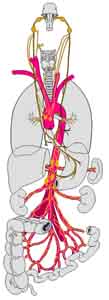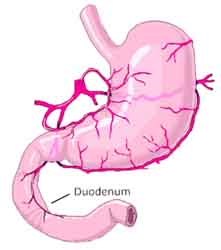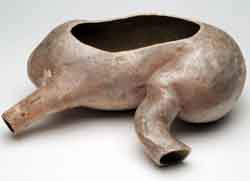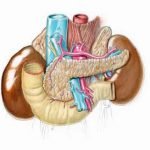We conclude our exploration of the anatomy and physiology of the stomach from a natural health perspective and examine the three phases of stomach digestion. In the process, we return to our comparison of the digestive systems of carnivores, omnivores, frugivores, and humans to get a better handle on what we were designed to eat.
In the last newsletter (part 1 in our series on the digestive system), we began our exploration of the anatomy and physiology of the stomach from a natural health perspective. In this issue, Part 2, we finish that exploration by exploring the three phases of stomach digestion. This is crucial to understanding how to treat diseases such as acid reflux and peptic ulcers — and why typical treatments such as antacids and proton pump inhibitor drugs that your doctor prescribes may actually make things worse long term. Along the way, we will return to our comparison of the digestive systems of carnivores, omnivores, frugivores, and humans to get a better handle on what we were designed to eat. And most importantly, we will begin to touch on those things that can go wrong inside the stomach and how you can prevent or correct them.
That said, let’s pick up where we left off, with a discussion of the three phases of digestion. (N ote: if you have not already done so, you might want to read Your Stomach, Part 1 so you don’t get lost.)
Gastric secretion and the regulation of food moving through the stomach goes through three phases
The three phases of digestion (cephalic, gastric, and intestinal) are regulated by both neural, blood, and hormonal factors, and there is much overlap and redundancy.
Cephalic phase
 The first phase is called the cephalic or neural phase. This phase actually occurs before food even enters the stomach and involves preparation of the body for eating and digestion. In fact, forget food entering the stomach. It can be triggered by the mere smell of food, or for that matter, just the thought of food. Sight, smell, and thought stimulate your cerebral cortex. Just think for a moment how the smell of your favorite dinner can make your mouth water, or how just thinking of eating can make your stomach growl and gurgle. Once your brain has picked up on the taste and/or smell of food, the stimulus is sent to the hypothalamus and the medulla oblongata (the reptilian part of the brain located in the brain stem). From there, it runs down the vagus nerve, which connects to every major organ in the body (except the adrenal glands) and specifically controls the cephalic phase of digestion in the stomach. The word vagus has the same root as the word vagrant and means much the same thing in the body – wanderer. As you can see in the illustration on the right, the vagus nerve (in yellow) starts in the brain stem and runs down through your torso, playing a role in regulating everything from your heart and lungs to your stomach and intestines. In the stomach, the vagus nerve controls muscular contraction, telling the stomach to “grind” harder. It also stimulates secretion of HCL and pepsinogen and stimulates mucous production to protect against autodigestion of your stomach wall. And finally, it stimulates the release of gastrin from the antrum, providing yet another signal for the stomach to produce HCL. Gastric secretion during the cephalic phase rises to only 30% of maximum. Acidity in the stomach is not buffered by food at this point and thus acts to inhibit any further production of digestive juices.
The first phase is called the cephalic or neural phase. This phase actually occurs before food even enters the stomach and involves preparation of the body for eating and digestion. In fact, forget food entering the stomach. It can be triggered by the mere smell of food, or for that matter, just the thought of food. Sight, smell, and thought stimulate your cerebral cortex. Just think for a moment how the smell of your favorite dinner can make your mouth water, or how just thinking of eating can make your stomach growl and gurgle. Once your brain has picked up on the taste and/or smell of food, the stimulus is sent to the hypothalamus and the medulla oblongata (the reptilian part of the brain located in the brain stem). From there, it runs down the vagus nerve, which connects to every major organ in the body (except the adrenal glands) and specifically controls the cephalic phase of digestion in the stomach. The word vagus has the same root as the word vagrant and means much the same thing in the body – wanderer. As you can see in the illustration on the right, the vagus nerve (in yellow) starts in the brain stem and runs down through your torso, playing a role in regulating everything from your heart and lungs to your stomach and intestines. In the stomach, the vagus nerve controls muscular contraction, telling the stomach to “grind” harder. It also stimulates secretion of HCL and pepsinogen and stimulates mucous production to protect against autodigestion of your stomach wall. And finally, it stimulates the release of gastrin from the antrum, providing yet another signal for the stomach to produce HCL. Gastric secretion during the cephalic phase rises to only 30% of maximum. Acidity in the stomach is not buffered by food at this point and thus acts to inhibit any further production of digestive juices.
As a side note, it is the vagus nerve that is triggered when we smell food or think about it (or hear a bell ring if you’re one of Pavlov’s dogs). It is that stimulus of the vagus nerve that starts us salivating in anticipation of food.
Gastric phase
The second phase of stomach digestion/secretion is the gastric phase, which is both neural and humeral (humeral means things circulating in the blood). This phase is initiated by the presence of the bolus (the chewed up food when it is first swallowed) in the stomach. In fact, the gastric phase is activated by the stretching of the stomach wall as more and more food enters the stomach. Distention activates nerve reflexes in the stomach wall, which in turn activate the release of acetylcholine (a neurotransmitter) which stimulates the release of yet more gastric juices.
In addition, as protein enters the stomach, it binds to hydrogen ions, which raises the pH of the stomach from around pH 2.0-3.5 to pH 4.0 or higher. (Note: acids are defined by the number of H+ ions they hold in a solution. Thus, binding H+ ions makes a solution more alkaline.) As the pH climbs, inhibition of gastrin and HCl secretion is lifted. This triggers G cells to release more gastrin, which in turn stimulates parietal cells to secrete more HCl.
Everyone wants to know how strong stomach acid is. As released by the parietal cells in your stomach, stomach acid has a pH of about 0.8-1.0. Stunningly that’s about the same strength as battery acid! However, as soon as it starts mixing with food, it will quickly rise to a pH of about 2.0-3.5 – a pH your stomach will try and maintain for proper digestion. As more and more food enters the stomach, however, it continues to dilute the acid in the stomach, thus causing the pH to rise. Chemoreceptors in the stomach detect the rise in pH and signal the brain to produce more acid. In addition, as described above, protein in particular enters the stomach and binds to hydrogen ions, thus neutralizing some of the acid and raising the pH of the stomach. This rising and falling of pH in the stomach continues throughout the gastric phase, which lasts about three to four hours.
Once you understand the mechanisms of HCL production involved in the gastric phase, you can instantly understand the problem with using antacids such as Tums. Although they effectively can neutralize excess stomach acid short term, the very act of raising pH in the stomach while food is present tells the body to produce more acid to compensate. Thus, you get short term relief, followed immediately after by another round of excess stomach acid. On the other hand, moving chyme on through the stomach lessens the distension of the stomach, which signals that less acid is needed. In addition, eating live foods or using digestive enzymes with your meal allows for up to 75% of the meal to be digested by enzymatic action, cutting the time needed for gastric digestion by three-quarters – thus moving chyme through the stomach that much faster. This cuts stomach acid levels in two ways:
- Less acid is needed in the first place since the meal is 75% digested before acid levels reach 100%.
- Being largely pre-digested, food moves through the body and antrum of the stomach more quickly, thus cutting off the feedback loop calling for more acid.
Incidentally, the gastrin produced by the enteroendocrine cells in the antrum is not released directly into the stomach, where it would be unable to trigger HCL production in the body of the stomach because cells in the stomach wall are protected by a layer of mucous. Instead, it is released into the bloodstream, where it then circulates back to the blood vessels that feed the stomach, where it can then trigger the parietal cells in the body and antrum of the stomach. As stated earlier, gastrin circulating in the bloodstream also shuts the esophageal sphincter and opens the pylorus – leading into the duodenum and the small intestine. The total effect is to force a small amount of chyme across the pylorus into the duodenum. As one might imagine, this has implications for acid reflux disease, which we’ll talk more about in our next newsletter.
 Intestinal phase
Intestinal phase
The intestinal phase refers to that part of digestion/secretion triggered when chyme reaches the duodenum. The high acid chyme triggers three events that affect the stomach.
- First, the distension caused by the chyme entering the duodenum sends impulses to the brain that then sends signals down the vagus nerve telling the stomach to stop producing stomach acid.
- Distension also causes direct nerve stimulation of the stomach telling it to stop producing gastric juices.
- And finally, the distension and the high acid content of the chyme cause the pyloric sphincter to tighten – thus preventing any more food from entering the duodenum. In effect, the intestines slow down gastric digestion and emptying to give themselves more time to prepare for food. The more chyme that goes into the intestines, the more the intestines try to say, “Slow things down. I need more time.”
At this point, it’s worth taking a look at some “numbers” involved here. The pyloric region of the stomach holds about 30 ml of chyme (about 1 oz). It allows only liquids and small particles of chyme, about 3 ml at a time, to pass through the valve with each peristaltic wave (when the valve is open). The contractions of the pylorius decrease the opening of the valve – as does the action of gastrin. This results in the majority of the chyme remaining in the stomach getting remixed again and again. Since the rate of peristaltic waves is a constant three per minute, that means the stomach only passes about one-third of an ounce of chyme into the duodenum per minute – again, when the pyloric valve is open. Thus it takes approximately three to four hours for an “average” meal to fully pass from the stomach. During that time, as each tiny wave of food enters the duodenum, the duodenum sends out its excitatory and inhibitory signals. Larger than average meals can take many hours longer to clear the stomach.
Peristalsis in the antrum of the stomach
Duodenum
Although the duodenum is more anatomically aligned with the small intestine than the stomach, physiologically it is more oriented to digestion than absorption. In any case, we will quickly examine the duodenum in this newsletter.
Anatomically, the duodenum is defined as the first 12 inches of the small intestine. Very little absorption takes place in the duodenum — mostly just transport and mixing. Its primary roles are to signal the stomach when to stop producing stomach acid, to regulate the flow of chyme into the intestinal tract, neutralize the hydrochloric acid in the chyme, and to start the digestive juices and insulin flowing from the pancreas and gallbladder. Also, as we discussed earlier, the duodenum releases three hormones when chyme (especially fatty acids and glucose) enter the duodenum. These are:
- GIP, the gastric inhibitory hormone (GIP), was once thought to primarily inhibit gastric secretion (thus its name) and the movement of chyme through the system, which, in fact, it does at high enough levels. However, medical researchers now believe that the primary role of GIP is to trigger an increase in insulin secretion from the pancreas in preparation for handling the ingestion of high glycemic carbohydrates.
- Secretin targets the pancreas and causes it to secrete a bicarbonate-rich fluid that flows into the duodenum. Bicarbonate, of course, is highly alkaline and thus neutralizes the stomach acid in the chyme, establishing a more alkaline pH favorable to the action of digestive enzymes – both those temporarily rendered inactive by the HCL in the chyme and those produced by the pancreas and released into the intestines, which will soon begin finishing off the digestion of the chyme. And finally, secretin inhibits the release of gastrin, which thereby reduces acid secretion in the stomach.
- Cholecystokinin CCK) inhibits gastric emptying, thus regulating the flow of chyme from the stomach into the duodenum. As we discussed earlier, CCK is released as partially digested food enters the duodenum. In addition to regulating flow, its other primary role is to trigger the pancreas and gallbladder to respectively release digestive enzymes and bile, thereby assisting in the digestion down the line of the proteins and fats entering the duodenum.
Gastric emptying
Gastric emptying is promoted by the distension of the antrum, partially digested protein fragments (amino acids), and drugs such as alcohol and caffeine.
- All of the above tend to increase gastrin secretion and stimulation of the vagus nerve.
- All of the above tend to close the lower esophageal sphincter, open the pylorus, and increase gastric peristaltic contractions.
That’s why having a cup of coffee in the morning or a drink before dinner stimulates hunger, because it causes the stomach to empty, decreases distension, which triggers hunger.
On the other hand, as we just discussed above, gastric emptying is inhibited by distension of the duodenum as food enters and by the presence fatty acids, glucose, and protein fragments in the duodenum. These are all triggers to slow the emptying of the stomach’s contents. In addition, increased secretion of CCK (cholecystokinin), secretin, and GIP (gastric inhibitory peptide (hormone) slow down gastric emptying.
As we discussed earlier, it takes about three to four hours for an average meal to completely empty from the stomach. However, that said, different types of food move through at different rates. Fatty foods remain in the stomach for the longest time; proteins remain an intermediate time; and carbohydrates remain for the shortest time. Although proponents of proper food combining would have a heart attack to hear this, combining all three elements (proteins, fats, and carbohydrates) at a meal provides the longest lasting sense of satiety. Quick signals from carbohydrates tell the brain you’re full, followed by protein signals, and finally by fat signals. All telling your brain that you’re still working on the meal and that you’re still satiated. Diets that concentrate on only one element do not prolong satiety.
That said, proper food combining addresses an entirely different issue. By combining proteins fats and carbohydrates in the proper manner and not mixing bad matches in any given meal, you optimize the digestive process for those particular foods. Now it is certainly true, as many medical experts have stated, that much nonsense has been spouted in the name of food combining. And it is also true that it does not produce the same levels of satiety as seen when mixing foods. However, proper food combining absolutely minimizes gas and intestinal distress and leaves you feeling more energized after eating.
On a related note, it should be mentioned that your stomach has the capacity to stretch significantly. In fact, not only can the stomach stretch quite a bit, but it tends to collapse quickly when stretched, causing hunger to return quite soon after a large meal. How far can it stretch? After a Thanksgiving dinner, it can stretch almost down to your pelvis. Then it empties and you feel hungry again.
Grazing on the other hand does not overstretch the stomach, and keeps some food in there most of the day, which means you are constantly sending satiety signals to the brain. In other words, 6 small snack/meals will keep you feeling more satiated than 3 large meals – or any large meals, for that matter.
Carnivore, omnivore, frugivore
Now, having taken a comprehensive look at the anatomy and physiology of the human stomach, let’s continue our comparison of intestinal tracts that we started in two newsletters ago. Whereas at that time we compared teeth, let’s now compare stomachs.
Carnivore and omnivores
 We can group these two sets of animals together, since the differences between the stomachs of the two are minimal. For both groups, the majority of digestion occurs in the stomach (which, as you can see from the lion’s stomach on the left, is rounder and more sack-shaped than the human stomach and has a much higher concentration of acid for digesting not only animal tissue, but also bone – as anyone who has seen the movie Snatch knows). In fact, the stomachs of carnivores and omnivores secrete powerful digestive enzymes and digestive juices with about 10 times the levels of hydrochloric acid found in a human stomach. To be precise, the pH in carnivores and omnivores with food in their stomachs is less than or equal to about 1.0. For humans, on the other hand, pH ranges from 2.0-4.5 with food in the stomach. This is a huge difference.
We can group these two sets of animals together, since the differences between the stomachs of the two are minimal. For both groups, the majority of digestion occurs in the stomach (which, as you can see from the lion’s stomach on the left, is rounder and more sack-shaped than the human stomach and has a much higher concentration of acid for digesting not only animal tissue, but also bone – as anyone who has seen the movie Snatch knows). In fact, the stomachs of carnivores and omnivores secrete powerful digestive enzymes and digestive juices with about 10 times the levels of hydrochloric acid found in a human stomach. To be precise, the pH in carnivores and omnivores with food in their stomachs is less than or equal to about 1.0. For humans, on the other hand, pH ranges from 2.0-4.5 with food in the stomach. This is a huge difference.
Another difference is that food usually remains for days at a time in a carnivore’s stomach while it is digested (to a large extent) by enzymes present in the raw meat itself (a process called autolytic digestion). It is only after autolytic digestion that the highly concentrated HCL makes its appearance to break down the bone and gristle consumed with the meal. In addition, carnivores are adapted to process huge amounts of food at a time (up to 25 percent of their body weight or more) then eat nothing for days at a time. This doesn’t sound very much like the human digestive process (except on all-you-can-eat nights at the Troff N Brew Restaurant)
Frugivore
And, as might be expected, the human stomach is remarkably similar to the chimpanzee’s stomach, both in terms of shape and gastric juice content. Using that as a guide, we once again are looking at a diet that consists largely of fruits and nuts, with a maximum of about 3% meat. Again, as explained two newsletters ago, the human digestive system is remarkably adaptable – but there are consequences when it is forced to adapt.
Conclusion
This concludes our discussion of the anatomy and physiology of the stomach. In our next newsletter (part 4 in our series on the digestive system), we will focus in on the primary stomach disorders of our time and how they can be addressed using natural health alternatives:
- Peptic ulcers
- Acid reflux disease
And as part of our discussion of acid reflux disease, we will also explore the impact of suppressing stomach acid production on:
- Nutrient absorption
- Mineral absorption
- Vitamin B12 utilization
- Satiety
Continue reading Jon’s series about digestive health:
Overview of the Digestive System
Your Stomach, Part 1
Your Stomach, Part 3












I am not convinced that
I am not convinced that humans are supposed to eat fruit and nuts with a 3pc meat maximum. This section was very short… and I am absolutely convinced that such a diet would not provide the protein needs necessary to maintain and fuel an average size adult body.
Perhaps you didn’t realize
Perhaps you didn’t realize that top athletes like Carl Lewis (track), Mac Danzig (MMA), Ricky Williams (football), Robert Parish (basketball), and Hank Aaron(baseball), were vegetarian. Fortunately, their non-meat diets were able to maintain and fuel their larger than average-sized adult bodies.
Jon, can you tell me what
Jon, can you tell me what happens to the H+ part of HCL after the food is digested? Is the H+ absorbed into the body somehow or does it combine with another chemical? The reason I am asking is that H+ is supposed to be one of the Best Anti-oxidants
produced in the body. So I would assume the body would re-use this H+ somewhere else in the body as the human body is a Smart Machine.
Thanks Jon and I appreciate the high quality products that you provide for all of us.
Garry
Hi, Jon,…my vagus nerve is
Hi, Jon,…my vagus nerve is cutted during fundoplication..my life is a horrormovie since than…feeeling so ill and in so much pain. The did the pancreas polypetide test and it confirmed teh nerve damage. I went into a hypo of 1,6 in the hospitals.
I have hypo’s, tachycardia, pain, insomnia,bloating, irregular uncontrolled bowelmovements….and even hearingloss one side…doctors say it is not connected the hearingloss…but I know so many who also had this operation and are in the same boat…is there something that can helps with the pain?
Thanx for ypur reply
Regards Mariette